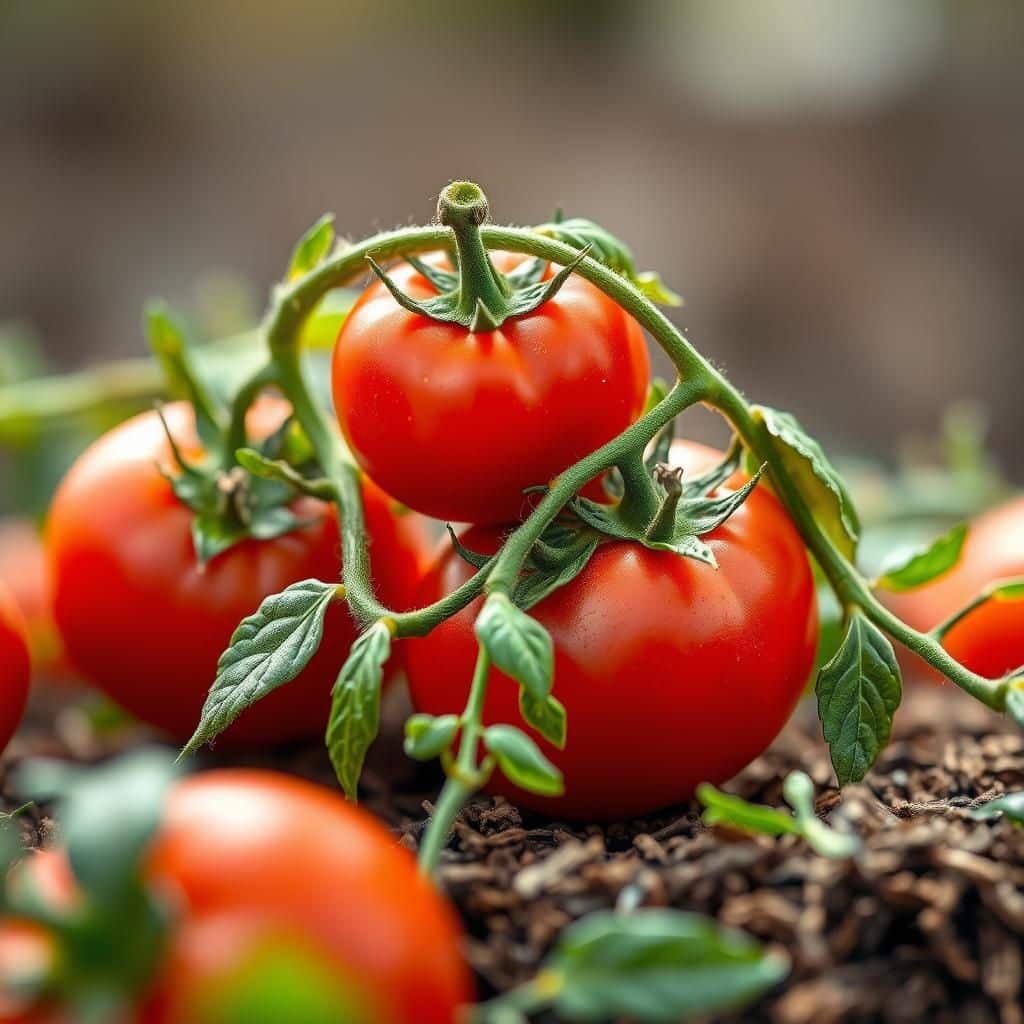The Ultimate Guide to the Best Food for Growing Tomatoes Successfully

Growing tomatoes can be a rewarding experience, but it requires the right techniques and knowledge to achieve the best results. One of the most crucial factors in cultivating healthy, vibrant tomato plants is providing them with optimal nutrition. In this ultimate guide, we will explore the best food options for growing tomatoes successfully, from essential nutrients to organic fertilizers, and the timing of application. Whether you're a novice gardener or a seasoned pro, understanding how to nourish your tomato plants will enhance their growth, improve fruit quality, and ultimately lead to a bountiful harvest. Let's dig into the specifics of tomato nutrition!
Best Food for Growing Tomatoes
To ensure healthy growth and bountiful fruit production, tomatoes require a balanced diet rich in essential nutrients. The best food for growing tomatoes primarily includes organic matter, high-quality fertilizers, and certain soil amendments. For optimal results, fertilizers should be high in nitrogen early in the growing season to promote foliage development, then shift to a higher phosphorus and potassium ratio as the plants begin to flower and set fruit. Additionally, amendments such as compost, bone meal, and worm castings can enhance soil fertility and improve water retention. A soil test is advisable to tailor the nutrient supply to the specific needs of your garden, ensuring plants receive adequate nutrition for vigorous growth.
Nitrogen-Rich Fertilizers
Nitrogen is a crucial nutrient for the early growth of tomatoes, as it aids in leaf and stem development. Using fertilizers that are high in nitrogen, such as those with a higher first number in their N-P-K ratio, can promote lush and healthy foliage. However, it is important to transition to other types of fertilizers as the plants progress towards blooming and fruiting to avoid overly leafy plants with few tomatoes.
Phosphorus for Root Development
Phosphorus plays a vital role in the development of roots and flowers, which is essential for tomato plants as they begin to establish themselves. Fertilizers that contain bone meal or rock phosphate can provide a slow-release source of phosphorus, ensuring that plants have consistent access to this important nutrient during critical growth stages.
Potassium for Fruit Production
Increasing the availability of potassium during the ripening phase is essential for enhancing the flavor and quality of tomatoes. Fertilizers high in potassium, such as potassium sulfate or kelp meal, are recommended as they promote fruit development, improve overall plant health, and assist in the plant's stress management during hot or challenging weather conditions.
Organic Amendments
Incorporating organic amendments like compost, well-rotted manure, or worm castings into the soil can significantly improve its nutrient profile and structure. These amendments not only provide essential nutrients but also enhance microbial activity in the soil, fostering a healthy ecosystem that supports robust tomato growth and improves moisture retention.
Soil Testing and Nutrient Management
Conducting a soil test can provide valuable insights into the nutrient content and pH levels of your garden soil. By understanding the specific needs of your soil, you can adjust your fertilization strategies accordingly, ensuring that tomatoes receive adequate levels of nitrogen, phosphorus, potassium, and other trace minerals necessary for optimal growth and production.
| Nutrient | Role | Source |
|---|---|---|
| Nitrogen | Leaf and stem growth | Urea, ammonium nitrate |
| Phosphorus | Root development and flowering | Bone meal, rock phosphate |
| Potassium | Fruit quality and stress resistance | Potassium sulfate, kelp meal |
| Organic Matter | Soil structure and nutrient supply | Compost, manure |
What is the best thing to feed tomatoes?

To properly feed tomatoes and ensure healthy growth and fruit production, a balanced fertilizer is essential. The best thing to feed tomatoes generally includes a combination of macronutrients and micronutrients that promote strong root development, flowering, and fruiting. Here are key feeding strategies:
Understanding Tomato Nutritional Needs
Tomatoes require a variety of nutrients to thrive. The three primary macronutrients are nitrogen (N), phosphorus (P), and potassium (K). Each plays a unique role in the plant’s health:
- Nitrogen: Essential for leaf growth and overall plant vigor.
- Phosphorus: Important for root development and flower production.
- Potassium: Aids in water regulation and enhances fruit quality.
Organic vs. Synthetic Fertilizers
Deciding between organic and synthetic fertilizers can impact the health of your tomato plants. Each type has its advantages:
- Organic fertilizers: Often derived from natural sources, promote long-term soil health and improve nutrient retention.
- Synthetic fertilizers: Provide quick nutrient availability but can lead to soil degradation if used excessively.
- A well-balanced approach may include both, using organic for the soil base and synthetic for boost during peak growth.
When to Feed Your Tomatoes
Timing is critical when feeding tomatoes for optimal growth. A fertilization schedule can be beneficial:
- Apply a starter fertilizer when planting to kickstart growth.
- Feed with a balanced fertilizer every 4-6 weeks during the growing season.
- Use a high potassium fertilizer as flowers develop to promote fruit set.
Homemade Fertilizer Options
Many gardeners opt to make their own fertilizers using common kitchen scraps or garden materials. Here are a few ideas:
- Compost: Provides a slow-release source of nutrients and improves soil structure.
- Eggshells: Crushed and mixed into the soil add calcium, which is crucial for fruit development.
- Banana peels: Rich in potassium and can be added directly to the planting hole.
Common Feeding Mistakes to Avoid
While feeding tomatoes, certain mistakes can hinder growth and yield. Awareness of these can help:
See also:
- Over-fertilizing: Can lead to excessive foliage at the expense of fruit production.
- Neglecting soil testing: Determines existing nutrient levels and avoids unnecessary applications.
- Feeding too late in the season can impede the plant's natural process of hardening off before the first frost.
What is the secret to growing good tomatoes?

To grow good tomatoes, several factors come into play that ensure not only a healthy plant but also a bountiful harvest of flavorful fruit. The secret lies in understanding the needs of the tomato plant and providing them with the right care, nutrients, and environment.
Soil Quality
The foundation of any successful garden is the soil. Tomatoes thrive in well-drained, nutrient-rich soil. Here are some key points to enhance soil quality:
- pH Levels: Aim for a soil pH between 6.0 and 6.8 to ensure optimal nutrient uptake.
- Organic Matter: Incorporate compost or well-rotted manure to improve soil fertility and structure.
- Drainage: Ensure adequate drainage to prevent root rot; raised beds can help in areas with heavy clay soil.
Sunlight Requirements
Tomatoes require ample sunlight for photosynthesis and fruit production. Understanding their light needs is crucial:
- Full Sun Exposure: Tomatoes ideally need at least 6 to 8 hours of direct sunlight daily.
- Sunlight Position: Plant tomatoes where they receive morning sun, which helps dry the dew and prevent disease.
- Temperature Considerations: Excessive heat can damage blossoms; aim to grow them in temperatures ranging from 70°F to 85°F (21°C to 29°C).
Watering Techniques
Proper watering is vital for tomato plants to flourish. Here are effective watering strategies:
- Consistent Moisture: Keep the soil consistently moist but never soggy, as fluctuations can lead to blossom end rot.
- Drip Irrigation: Utilize drip irrigation systems to deliver water directly to the roots while minimizing wetness on the foliage.
- Mulching: Apply mulch around the plants to retain soil moisture and regulate temperature.
Pest and Disease Management
Tomatoes are susceptible to various pests and diseases, so monitoring is essential:
- Regular Inspection: Check plants for signs of common pests like aphids, whiteflies, and hornworms.
- Preventative Measures: Use row covers and companion planting to discourage pests and enhance plant health.
- Fungal Diseases: Utilize fungicides or organic options when needed, and practice crop rotation to prevent soil-borne diseases.
Nutrient Management
Tomatoes need a balanced supply of nutrients to support their growth and fruit development:
- Fertilization Schedule: Test your soil and fertilize with a balanced fertilizer or one high in phosphorus and potassium.
- Micronutrients: Ensure the presence of calcium, magnesium, and other micronutrients to enhance the growth of strong plants.
- Organic Options: Use organic fertilizers like fish emulsion or bone meal to provide a slow release of nutrients.
Which fertilizer is best for tomato plant growth?

The best fertilizer for tomato plant growth is one that provides the essential nutrients these plants need to thrive, particularly nitrogen, phosphorus, and potassium. A balanced fertilizer with an N-P-K ratio of 5-10-10 or 10-20-20 is often recommended. It's crucial to choose a fertilizer that supports not only foliage growth but also flowering and fruit set. Additionally, using organic fertilizers, such as compost, well-rotted manure, or fish emulsion, can boost soil health and enhance nutrient availability. Here’s a detailed breakdown of aspects to consider when selecting fertilizer for tomatoes.
Understanding Tomato Nutrient Requirements
Tomato plants have specific nutrient requirements throughout their growth stages. They primarily need:
- Nitrogen: Essential for leaf and stem development.
- Phosphorus: Supports root development and flowering.
- Potassium: Involved in water regulation and fruit quality.
By understanding these nutrient needs, growers can tailor their fertilizer application to promote robust plant health.
Types of Fertilizers for Tomatoes
There are several types of fertilizers suitable for tomato plants, including:
- Granular Fertilizers: Slow-release options are best for long-term nutrition.
- Liquid Fertilizers: Fast-acting and ideal for addressing nutrient deficiencies quickly.
- Organic Fertilizers: Environmentally friendly choices such as compost and manure.
Choosing the right type can greatly affect plant performance and yield.
Application Timing for Maximum Growth
Timing is crucial when applying fertilizer to tomatoes:
See also:
- Pre-Planting: Mix fertilizer into the soil to provide a nutrient-rich environment.
- During Transplanting: A starter solution can help young plants establish.
- Mid-Growth: Side-dress with fertilizer as fruit begins to set, boosting yield.
Applying nutrients at the right time ensures that plants can utilize them effectively.
Signs of Nutrient Deficiency
Be observant of your tomato plants for signs that they may need fertilizer:
- Yellowing Leaves: Indicates a possible nitrogen deficiency.
- Poor Flowering: Suggests insufficient phosphorus.
- Small or Poor-quality Fruit: Often linked to potassium deficiency.
Recognizing these signs allows for timely interventions to restore health.
Benefits of Organic vs. Synthetic Fertilizers
Both organic and synthetic fertilizers have their advantages:
- Organic Fertilizers: Enhance soil structure and promote beneficial microbial activity.
- Synthetic Fertilizers: Offer precise nutrient ratios and rapid availability.
- Combination Approaches: Using both can improve overall soil fertility and plant health.
Weighing the benefits of each can help in making informed decisions based on specific gardening goals.
What is the best thing to put on tomato plants?

To ensure your tomato plants thrive and produce an abundance of fruits, it is essential to use the right combination of materials and amendments. The best thing to put on tomato plants includes a mixture of fertilizers, organic matter, and mulch.
Organic Fertilizers
Using organic fertilizers is one of the best ways to nourish tomato plants. They provide essential nutrients without the harsh chemicals found in synthetic options.
- Compost: Rich in nitrogen, phosphorus, and potassium, compost improves soil structure and adds beneficial microorganisms.
- Bone Meal: This slow-release fertilizer supplies phosphorus and calcium, supporting root growth and fruit development.
- Fish Emulsion: A liquid fertilizer that offers a quick nutrient boost, it's high in nitrogen and is particularly good for leafy growth.
Mulching
Mulching around tomato plants is an excellent practice that serves multiple purposes. It can help regulate soil temperature and retain moisture.
- Straw: An affordable option, straw provides insulation and helps suppress weeds while allowing water to penetrate.
- Bark Mulch: This type of mulch provides a more permanent solution, reducing evaporation and moderating soil temperature.
- Grass Clippings: As a free resource, they break down quickly and add nitrogen back into the soil while helping to retain moisture.
Soil Amendments
Enhancing the soil where tomato plants grow is critical for their health and productivity. Adding amendments can greatly improve the soil’s nutrient content and structure.
- Pearlite: This lightweight amendment aerates the soil and improves drainage, preventing root rot.
- Vermicompost: Known for its rich microbial content, it enhances nutrient availability and contributes to overall plant health.
- Sulfur: Lowering soil pH, sulfur can create an optimal environment for nutrient absorption in tomato plants.
Watering Techniques
Proper watering is crucial for healthy tomato plants. Understanding the best techniques can lead to better growth and fruit production.
- Drip Irrigation: It delivers water directly to the plant roots, minimizing moisture on foliage and reducing the risk of diseases.
- Deep Watering: Encouraging deep roots, this method requires watering less frequently but more thoroughly.
- Consistent Schedule: Watering at the same time each day ensures that plants receive adequate moisture, especially during dry spells.
Companion Planting
Companion planting can enhance the growth of tomato plants and can naturally deter pests and diseases.
- Basil: Known to repel pests, basil can enhance tomato flavor and growth when planted nearby.
- Marigolds: These flowers deter nematodes and other pests, providing a protective barrier for tomato plants.
- Garlic: It has natural fungicidal properties and can help control aphids and whiteflies near your tomato plants.
Questions from Our Readers
What are the best nutrients for growing tomatoes?
To ensure your tomatoes thrive, it's essential to provide them with a balanced diet that includes nitrogen, phosphorus, and potassium. Nitrogen promotes leafy growth, while phosphorus supports root development and flowering. Potassium helps in producing fruits that are both flavorful and abundant, making these nutrients crucial for healthy tomato plants.
How often should I fertilize my tomato plants?
It's recommended to fertilize your tomato plants every 4 to 6 weeks during the growing season. You should start with a fertilizer high in nitrogen when the plants are young to encourage growth, then switch to a fertilizer that is higher in phosphorus and potassium as the plants begin to flower and set fruit. This strategy will help to maintain the right nutrient balance throughout the growth cycle.
See also:
What is the ideal soil type for growing tomatoes?
Tomatoes prefer well-drained, loamy soil that is rich in organic matter. A soil pH between 6.0 and 6.8 is ideal, as it allows for optimal nutrient uptake. Adding compost or well-rotted manure can enhance soil fertility and improve drainage, ensuring that your tomato plants have the best foundation for healthy growth.
Should I use organic or synthetic fertilizers for my tomatoes?
Both organic and synthetic fertilizers can be effective for growing tomatoes, but many gardeners prefer organic options for their long-term benefits. Organic fertilizers, such as bone meal and compost, improve soil health as they break down, providing a slow and steady supply of nutrients. However, synthetic fertilizers can yield quicker results; the choice depends on your gardening philosophy and soil management practices.

If you want to read more articles like The Ultimate Guide to the Best Food for Growing Tomatoes Successfully, we recommend you check out our Fertilisers category.
Leave a Reply
Related Articles